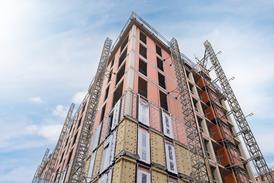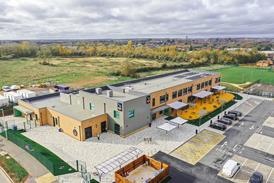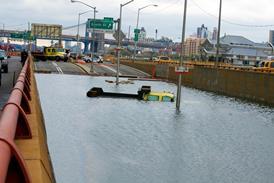Sustained rates of growth in air traffic are resulting in a continuous demand for increased airport capacity. In this month’s cost model, the Airports Specialist Group of cost consultant Davis Langdon & Everest examines the construction costs of airport facilities, along with commercial development on the airport campus
<B><FONT size=”+2”>Introduction</FONT></B>Air traffic in the UK is forecast to treble over the next 50 years. Growth will be centred on international airports such as Heathrow, Gatwick, Stansted and Manchester, but also on regional airports, many of which are underdeveloped. Regional air travel within Britain is also set to increase rapidly, with aircraft manufacturer BAe forecasting a doubling in the size of the regional aircraft fleet over 20 years. Development at all airports will be needed to accommodate more and larger aircraft, enhanced air traffic control facilities, expanded runway capacity, improved passenger facilities and better transport links.
In recent decades, government restrictions on investment by local authorities has constrained the development of regional airports, which has been funded out of profits rather than borrowings. The recent announcement of the lifting of borrowing controls for Manchester, Newcastle, Leeds/Bradford and Norwich airports will introduce greater freedom to expand and will allow local authority operators to invest directly in commercial facilities such as hotels or retail space.
The need for investment at regional airports has grown as the market for low-cost scheduled services, freight and charter flights expands. Investment in terminal and other facilities is necessary because users expect better facilities and surface transport connections.
Increasing awareness of the airport’s symbolic role as a regional or national gateway has led to a greater emphasis on the quality of the design and operation of airport facilities, with a recognition that high levels of service can raise the image of a region. The recent completion of new airports in Hong Kong, Bangkok and Kuala Lumpur, all designed by cutting-edge architects, is a clear indication of the importance of the airport brand to national or regional identity.
<B><FONT size=”+2”>Types of airport</FONT></B>Airports fall into three main categories related to capacity and scale of operation: international (more than 20 million passengers a year), national (2-20 million) and regional (up to 2 million).
Although passenger capacity is an important indicator, other factors such as the split of international, national and domestic flights served, the size of aircraft that can be accommodated and the range of non-airport facilities contribute to this classification.
International airports require more complex terminal facilities to accommodate passenger transfers. They also tend to have greater concentrations of business facilities, such as conference centres and hotels, which demand high airport capacity. A key factor affecting investment in international facilities is the need for an increasingly wide range of alternative transport systems, such as fixed rail links, to support growing passenger and freight flows and to minimise localised traffic congestion.
Regional airports are likely to serve as a focus for distribution and airline-related industry.
<B><FONT size=”+2”>Defining the scope of airport development</FONT></B>Airports are a diverse, specialised development type, although one with common design criteria worldwide. The terminal building is only one of many components that comprise the airport development; other are runways, fuelling and maintenance areas, stands and piers.
Terminal design has undergone a transformation as leading-edge designers have come to dominate the airport market. The latest generation of terminals, including Stansted, Chek Lap Kok in Hong Kong and Paris’ Charles de Gaulle, are spacious, light-filled and user-friendly, placing the emphasis on the needs of the passenger rather than the requirements of the process.
The main sources of airport revenue are landing fees, concession and lease income obtained from airlines, retail outlets and car park operators. Income from commercial activities typically comprises up to 50% of total revenue for larger airports, with 80% of that flowing from concessions related to car rental, car parking, retail and catering. To maximise commercial income, terminals need to encourage passengers to circulate through zones of commercial activity on their way from the entrance to the aircraft.
<B><FONT size=”+2”>Space standards</FONT></B>Space standards in airport terminals are closely related to planned terminal capacity, and in particular to peak passenger flows. Airport capacity is typically described in units of millions of passengers a year, although the critical measure for determining space standards is peak hourly passenger flows, which are dictated by the size and number of aircraft embarking and disembarking at any one time. The standards adopted vary from country to country, but in the UK, the standard busy rate, typically the 30th busiest hour in a year, is adopted as the benchmark passenger flow. Adoption of this standard provides a cost-effective design solution, but inevitably results in congestion during peak periods.
Space standards are published by international authorities such as the Federal Aviation Authority and the International Air Travel Association. These standards are used as benchmarks, with actual areas being established by the modelling of passenger density, flow rates, queue sizes and so on, based on an analysis of the proposed airport flight schedule and historic space-use data.
In practice, space standards vary in accordance with the location and target market of the airport terminal. Facilities aimed at the charter market will require more milling space and retail/catering to accommodate high passenger loadings during long check-in periods. Baggage screening takes place on the concourse in the Far East, but, in Europe, screening is incorporated into the baggage handling process. The numbers of meeters and greeters to be accommodated also varies geographically, from 0.2-0.5 per passenger in Europe to 2.5-6 in Africa and South-east Asia.
<B><FONT size=”+2”>Accommodating the requirements of airports, airlines and passengers</FONT></B>Airport design is complex because of the need to reconcile the requirements of a wide range of end-users. The differing needs of airport, airlines and passengers must be addressed within the overall framework set by international regulatory bodies such as IATA. In terminal layouts, for example, passengers want short walking distances from entrance to plane, whereas airlines look for efficient use of the space allocated to them and the airport authority must consider how the airport can expand.
Long-term growth and flexible development that can accommodate change is a key issue in airport development. A new generation of larger aircraft may reduce pressure on air space and runways, but will require the remodelling of aprons and hard standing, and will increase peak passenger flows. This will affect passenger and baggage handling within the terminal.
Short-term determinants of change include the mix of airline operators, airline deregulation, airline alliances, security and frontier issues, and commercial activities such as the possible abolition of duty-free sales in the European Union. For example, the recent growth of low-cost scheduled air services, such as Easy Jet and Go, operating out of regional airports has led to the improving of services through faster turnaround, rather than through enhanced terminal-based services.
Airport expansion requires investment throughout the chain, from airspace, runway, apron and stands to the terminal, associated facilities and surface transport links, access being a major constraint on future expansion. Planning issues are critical to airport expansion, with noise pollution continuing to dominate despite moves to phase out noisy aircraft. Surface traffic congestion also needs to be addressed, often through the control of spin-off development. Further environmental issues concerning water, air and habitat conservation also require detailed consideration.
<B><FONT size=”+2”>Design issues for airport terminals</FONT></B>Successful airport terminals are highly complex, functional buildings that link a high-quality public domain with the high-security, industrial environment of the airport apron. The terminal buildings should shield travellers from the complexity of the airport environment, providing an enjoyable and stress-free passage. Accordingly, a principal function of a terminal is the management of flows of passengers and their baggage through a series of filtering points – at check-in, security, passport control, gate lounge and boarding. Subsidiary facilities such as security, baggage handling and the provision of milling space and retail/catering facilities can compromise direct, unobstructed passenger flow to and from the aircraft.
The key issues that should be addressed in terminal design include:
- providing security and responding to changing international control and security requirements
- accommodating the variability of air traffic flow and the expected density of passenger flow
- accommodating commercial uses while minimising impact on airport circulation, orientation and signage
- facilitating the expansion of terminal facilities, through the use of modular components.
- The following design principles need to be addressed:
- <B>Clear passenger orientation</B>
- <B>Short concourse routes</B> Travelators should be provided where the kerb-to-gate distances exceed 300 m
- <B>Segregated departure and arrival flows</B> These are necessary only where justified by passenger densities
- <B>Avoiding level changes</B> These should be consistent with the passenger segregation strategy adopted
- <B>Multiple routes through security</B> These must operate within the constraints of statutory authorities’ policies on passenger and baggage handling
- Other issues specific to airports include:
- <B>Baggage handling systems</B> These are a significant determinant of terminal design. It is essential that system suppliers are appointed at an early stage to permit integration with structure, services and concourse layout. The increasing complexity of automated baggage handling systems, and recent malfunctions in new airports such as Chep Lap Kok, underlines the need to allow time for testing, commissioning and verifying of automated systems within the construction programme. Baggage handling plant demands a clear room height of 8-10 m and straight, level layouts wherever possible.
- <B>Segregation of space</B> This is vital to the maintenance of security standards, optimisation of passenger flows, and the clear division of public and operational areas. The segregation of airside/landside areas provides for the movement of staff, operating supplies, merchandise and baggage trolleys, as well as the primary flow of passengers. The number of routes to the airside should be minimised to reduce security threats and operational costs. Ceiling voids and so on also need to be secure.
- The multiple use of facilities such as check-ins, gate lounges and apron facilities maximises the use of fixed assets. Common User Terminal Equipment provides an information technology backbone for shared use of check-in and gate facilities, although shared facilities can conflict with an airline’s desire for a strong brand identity and dedicated space within the terminal. One solution could be the use of IT and virtual reality technology to provide flexible, branded space for multiple airline users.
- <B>Safety and security</B> Fire risks, safety and security issues are particularly complex because of airports’ deep-plan space, high-occupation densities, high fire risks related to shops and restaurants and the need to retain flexibility for future expansion and reconfiguration. High-risk areas are typically served by sprinkler and smoke extract systems, and lofty public concourses can double as smoke reservoirs. The layout of airside facilities should allow for “holding areas” to accommodate passengers safely during alerts.
- <B><FONT size=”+2”>Airport cost drivers</FONT></B>The complex operations associated with airports create a wide range of cost drivers that can add 10-20% to overall development costs. These include design, construction and airside working constraints, and safety requirements such as:
- Civil Aviation Authority restrictions on permanent building heights within safety glide slopes
- enhanced acoustic control and monitoring measures
- prevention of electromagnetic interference and the minimisation of radar signatures
- restrictions on building lighting and requirements for enhanced warning lighting
- CAA restrictions on crane heights and use of radios
- out-of-hours working and phased development to minimise disruption to passengers and aircraft
- controls on delivery and construction traffic to prevent airport road congestion
- additional costs of third-party liability insurance
- costs associated with airside/landside security
- training costs to obtain driving and works permits
- maintenance of airside fencing
- control of dust and debris to avoid ingestion by aircraft engines
- vibration limits when working close to sensitive equipment
- lack of airside space for site welfare, administration, storage and parking
- administration of security within restricted areas
- below-ground services clearance notices
- additional safety/signage/hazard identification measures.
- Terminal buildings are designed with a typical life expectancy of 50 years. Specification of components with shorter life-spans, such as building services and finishes, must be carefully considered, not only in terms of cost effectiveness but also to reduce maintenance that might obstruct airport operations.
- Life-cycle cost studies are essential to compare the initial costs, and the cleaning, repair, maintenance and replacement costs of alternative specifications. They should also consider capital amortisation and loss of accommodation during maintenance.
- The table below illustrates the relationship between the initial investment and whole-life costs associated with a range of floor finishes. Future cashflows are discounted at a 6% rate to the present-day equivalent. Whole-life costs include cleaning, repairs, periodic maintenance costs and replacement costs over 50 years. Tax allowances and residual values are also included.
- <B><FONT size=”+2”>Providing accommodation for the campus</FONT></B>Since airports act as a magnet for airport-related and unrelated commercial activity, the effective development of the airport campus needs to balance plans for the future expansion of airport capacity, short- and medium-term operational efficiency, the maximisation of the value of land assets and the wider planning environment.
- A broad range of facilities needs to be accommodated on airport sites, including terminal satellites and piers, air-cargo facilities and maintenance depots.
- Locations near to the airport are attractive for business parks, road and rail distributors and hotel/conference/training facilities. Within the airport itself, the demand for commercial space is even higher.
- Runways and taxiways determine the ultimate capacity of an airport. The overall length of a runway determines the type of aircraft that can use it, and the layout of taxiways and holding areas determines the maximum number of flight movements. The layout of runways, taxiways and aprons will affect the distance, time and fuel costs of aircraft taxiing, with the largest aircraft given priority where possible.
- Cargo facilities are a significant development component, with belly hold cargo revenues making a major contribution to airline revenue. Cargo centres, a distinctive distribution facility, need to be purpose-designed to accommodate growth and to facilitate the efficient transfer and distribution of air freight.
- Retail facilities typically take up 10-12% of terminal floor area and should be located within 10 m of main passenger flows in terminals. Retail units are usually let on three-to-five-year turnover leases. Further value-added services such as business centres and remote check-in facilities can enhance the airport brand.
- Large passenger flows are necessary to support a broad mix of hotels offering budget, mid-range and business class facilities. As the average stay at an airport hotel is only 1.2 nights, room size, prospect and leisure facilities tend to be less important to guests than enhanced services, particularly those targeted at business users.
- Flight catering facilities benefit from an off-airport location, typically within 10-15 minutes of the airport by road. Maintenance facilities should, where possible, be located to minimise disruption to runway operations caused by aircraft taxiing.
- <B><FONT size=”+2”>Procurement</FONT></B>The scale and scope of long-term airport development plans have encouraged airport clients to think long term when considering procurement strategy. An increasing number of airports are implementing partnering arrangements with key suppliers and contractors. This approach is particularly suited to airport construction projects because of:
- the requirement for early specialist advice on installations such as airfield lighting, air bridges, baggage handling systems and their impact on other building elements
- the suitability of modular check-in desks, public seating, signage and furniture, where added value can be generated through the expression of airport branding, and where bulk buying power can yield capital cost savings
- the need for continuity in the maintenance of key installations such as runways, apron services, baggage handling, lifts and passenger conveyors
- the need to retain specialist skills of airport construction.
- Formal partnering arrangements found on airport projects are also a response to the EU procurement directives that govern the procurement of goods and services for airports (the Utilities Directive, the Remedies Directive and the Services Directive). Use of the complex open procedure is mandatory unless a formal negotiated or restricted procedure, such as a partnering agreement, is in place. Airport clients also seek to reduce the administrative burden associated with EU procurement by tendering for, and appointing, multidisciplinary teams that include all necessary designers, cost consultants and specialist contractors and suppliers.
- The long-term benefit of partnering relationships is the opportunity to improve the construction process through benchmarking, target pricing, work structuring and the rationalisation of the supply chain.
- However, it should be recognised that partnering has potential disadvantages although these are usually offset by long-term benefits. These include:
- complacency in the project team
- lack of cross-fertilisation of innovative ideas from other sectors of the construction market
- uncompetitive pricing.
- <B><FONT size=”+2”>Cost model</FONT></B>The cost model features the new-build construction of an airport terminal building handling both domestic and international flights with a gross internal floor area of 25 000 m². The breakdown excludes the costs of piers, air bridges and baggage handling systems, as well as site preparation, external works, drainage and external services. The cost of a baggage handling system for a development of this size would be £6-7.5m, adding £290-360/m² to the cost of the scheme (including builder’s work, preliminaries and contingencies). The costs of Common User Terminal Equipment are also excluded. Adoption of a CUTE system would reduce the number of check-in desks – which cost about £25 000 each – by 25%.
- Costs are current in December 1998, based on a location in south-east England. The level of pricing assumes procurement on the basis of a competitive tender, with design responsibility for elements such as curtain walling and engineering services being taken by specialist contractors at an early stage. Adjustment should be made to the costs detailed in the model to account for variations in phasing, specification, site conditions, procurement route, programme and market conditions.
























No comments yet